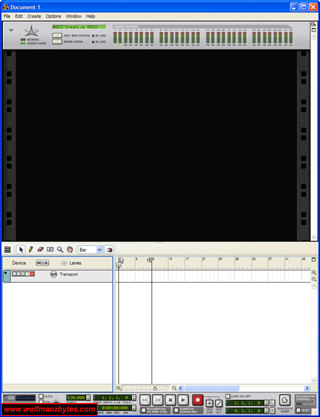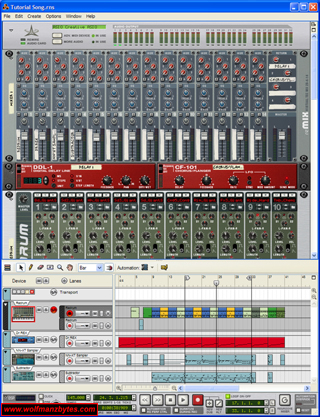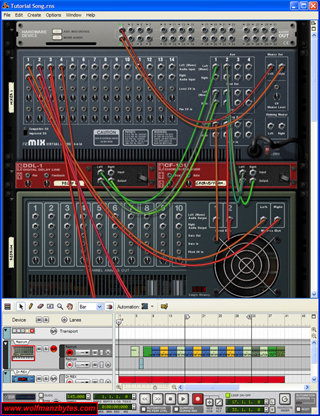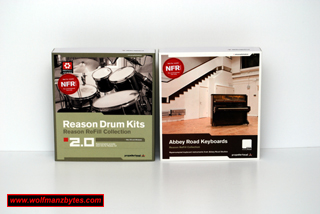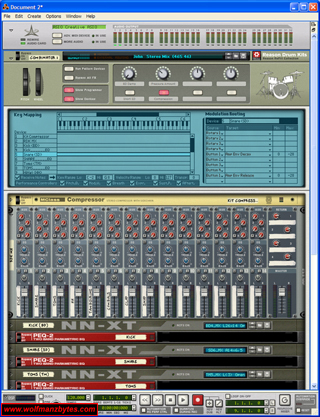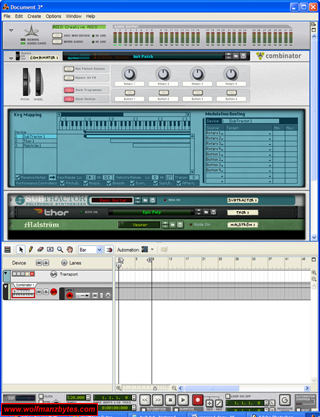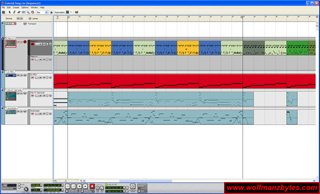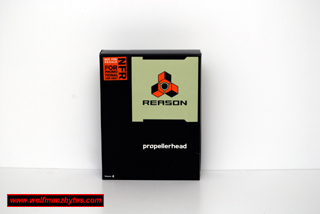
First a big thank you to Propellerhead for providing Reason 4.0 for this Review.
Today I get a chance to take a look at one of the most advanced music production environments I have seen to date.
Before I get to far into this review I should mention the System Requirements for reason 4.0 and they are the following..
-Windows XP SP2 or Vista
-Processor: Intel P4 / AMD Athlon XP or better
-Memory: 512 MB RAM minimum, 1 GB recommended
-Screen resolution: 1024x768
-2 GB free hard disk space
-DVD reader
-16-bit windows compatible audio card, preferably with DirectX or ASIO drivers
-Recommended: MIDI keyboard with built-in MIDI interface, or MIDI keyboard and MIDI interface
When you first load up Reason 4 you are greeted with a screen that for the most part is empty. On the top of the screen you should see an audio interface display that has numerous outputs. Looking under that you see a big black space and that’s where you can insert different devices such as mixers and synths and the like. Below the black space is the sequencer window and this is what you use to edit or lay down your various audio tracks. Below the sequencer window you see the transport and that’s what you use to play and record your music along with other various functions.
The whole idea behind Reason 4 is to emulate essentially a rack type of setup that you would see people use on stage or in a studio setup. As you add more and more devices to Reason 4 the rack grows and you can to scroll up and down with the scrollbars to see everything in the rack.
What I like about Reason 4.0 is how much thought went into this program. For example the rack space I was talking about previously, each of the devices that you insert into the rack has a maximized and a minimize button. Some of the devices you can insert into the rack have huge drop down panels that have lots of controls for various functions. The drop down panels take up a lot of room on the rack and so the fact you can minimize these panels is a good thing.
Below is a list of some of the Devices you get with reason 4.0.
Synths
-Thor
-Subtractor
-Malstrom
Samplers
-NN-XT
-NN19
Rhythm
-Redrum
-Dr.Rex
More devices
-Reason’s Sequencer
-ReGroove Mixer
-RPG-8 Arpeggiator
-The Combinator
-Matrix pattern sequencer
-The Rack
Effects
-RV7000
-MClass Mastering Suite
-BV512 Digital Vocoder
-Scream 4
In the screen shot below you can see what Reason 4 looks like with some devices loaded up. At the top of the screen you see the audio interface and then underneath the audio interface you have the 14 channel mixer and then you have the delay and chorus effect devices followed by the Redrum drum machine.
What’s really cool about Reason 4 is when you hit the Tab key on your keyboard the rack spins around and shows you the back end of the rack. In the picture below you’re seeing the back end view of the previous screen shot I talked about above.
For me this back end view of the rack is what makes reason so powerful in a lot of ways. I own a lot of rack based gear that I used to use for audio recording and to be able to have software that looks like the real hardware I have in terms of the jacks and the wiring is just incredible.
When you drop a device into the reason rack, reason for the most part will hookup the wiring so that you get the basic sound from the device. If you want to drop a device into the rack and not have it wired automatically then you just hold down the shift key while inserting the device and it will not be wired up. What really gets me about the wiring options is what all you can do with Reason 4. If you want to have a reverb device wired to the mixer a certain way you can do that with no problems at all.
To wire a device you just select the jack you want to run the wire from hold the mouse button down and you will see a virtual wire show up that you can then insert into another jack. The amount of different wiring configurations that you can do with reason is staggering. I have sat here many times looking at all the different things I could do with wiring and was simply blown away that propellerhead though of all these things with Reason 4.
One thing is for certain when you get a program like this it will be sure to eat up a lot of your time. Every time I start messing with the sounds that you can get off the different synths like Thor I find hours of my time disappearing.
One thing I should say about Reason 4 is a lot of people use it for Electronic type of music but you can get real sounding acoustic sounds with it as well. Below you can see a picture of two sound refills that I was sent with Reason 4 and they are Reason drum kits 2.0 and Abbey road keyboards.
What’s interesting about both of these refill kits is they are not just samples instead they are actual instruments / devices that you can drop into the rack. In the screen shot below you will see a screen shot of the Reason drum kits 2.0.
As you can see in the above screen shot this is a typical drum refill. You can adjust any of the drums volumes and also there EQ’s as well. If you want to go further and modify the drum sounds you can get right into the sampler for each drum sound and go nuts in there as well tweaking the sounds.
Another cool aspect of Reason 4 is the fact once you make your own unique sound you can then save that out as an instrument so that you can load it back up at another time. You can also do the same thing with effects, if you make a cool effect you can save that out as an effect so it to can be loaded at another time.
For me the device I had the most fun playing with was the combinator, in the screen shot below you can see that I have the combinator and within the combinator I have dropped in three synths that I have in minimize mode. What makes the combinator cool is the fact it can control whatever you drop into it. So as you can see in the screen shot, the combinator has a little keyboard display and on that display I have made it so that each of the synths will only be heard on certain parts of the keyboard.
I could also use the combinator to have all three synths play at the same time across the whole range of the midi keyboard. What makes the combinator a big deal is the type of layering of sounds you can get into with it. I could load up tons of synths and then assign them where I want them on my midi keyboard. Another interesting aspect of the combinator is the rotary dials it has on it. You can take these rotary dials and assign them to various parameters on the different devices. So again if you have 10 synts loaded up you can have one of the rotary dials adjust a parameter on all 10 synths.
Another cool thing with Reason 4 is the sequencer window that you see in the screen shot below. If you want to work in the sequencer window in the rack view where space is confined you can do that but you can also detach the sequencer window and have it go full screen and that’s nice for larger projects. The other thing I liked about the sequencer is the fact it’s really easy to use. The tools for doing things like drawing in notes and zooming in and the like are all at the top of the sequencer window and easy to find.
Last but not least I should mention that the amount of support for Reason 4 is also quite good in terms of user created videos and the like. If you go onto the Reason 4 web site they have several videos that show off various aspects of Reason 4. Another place I found some interesting user created videos showing how to do some neat stuff in reason was on youtube.
In conclusion Reason 4 is without doubt the most powerful music production environment I have used. The only real downside to Reason 4 is the cost of it and the cost of the refills however, you are getting very powerful software for the money. At the time of this Review you could purchase Reason 4 for about $400.00 U.S, the Reason Drum Kits 2.0 refill cost about $100.00 U.S, and the Abbey Road Keyboards refill cost about $185.00 U.S.
WolfManz611..

